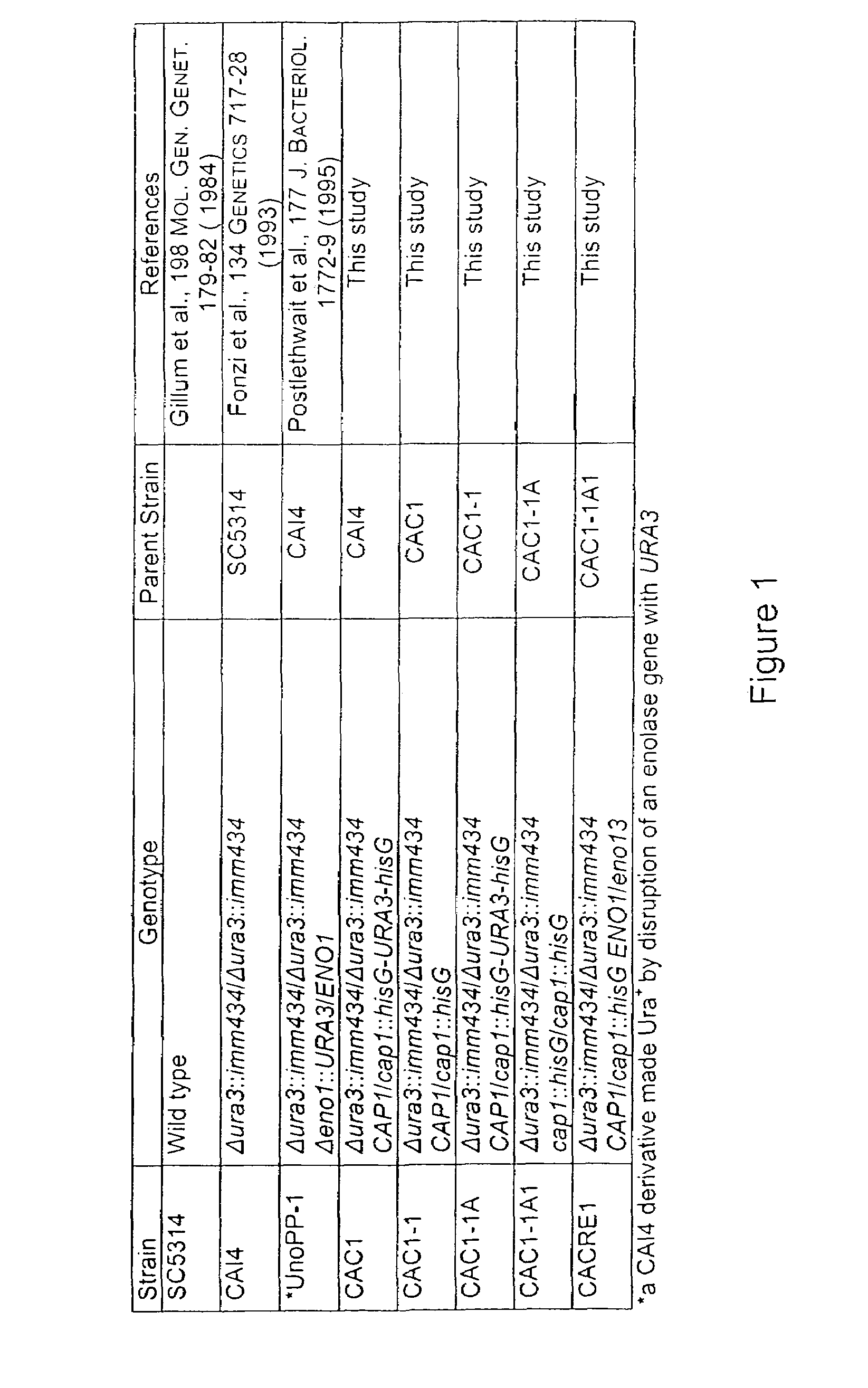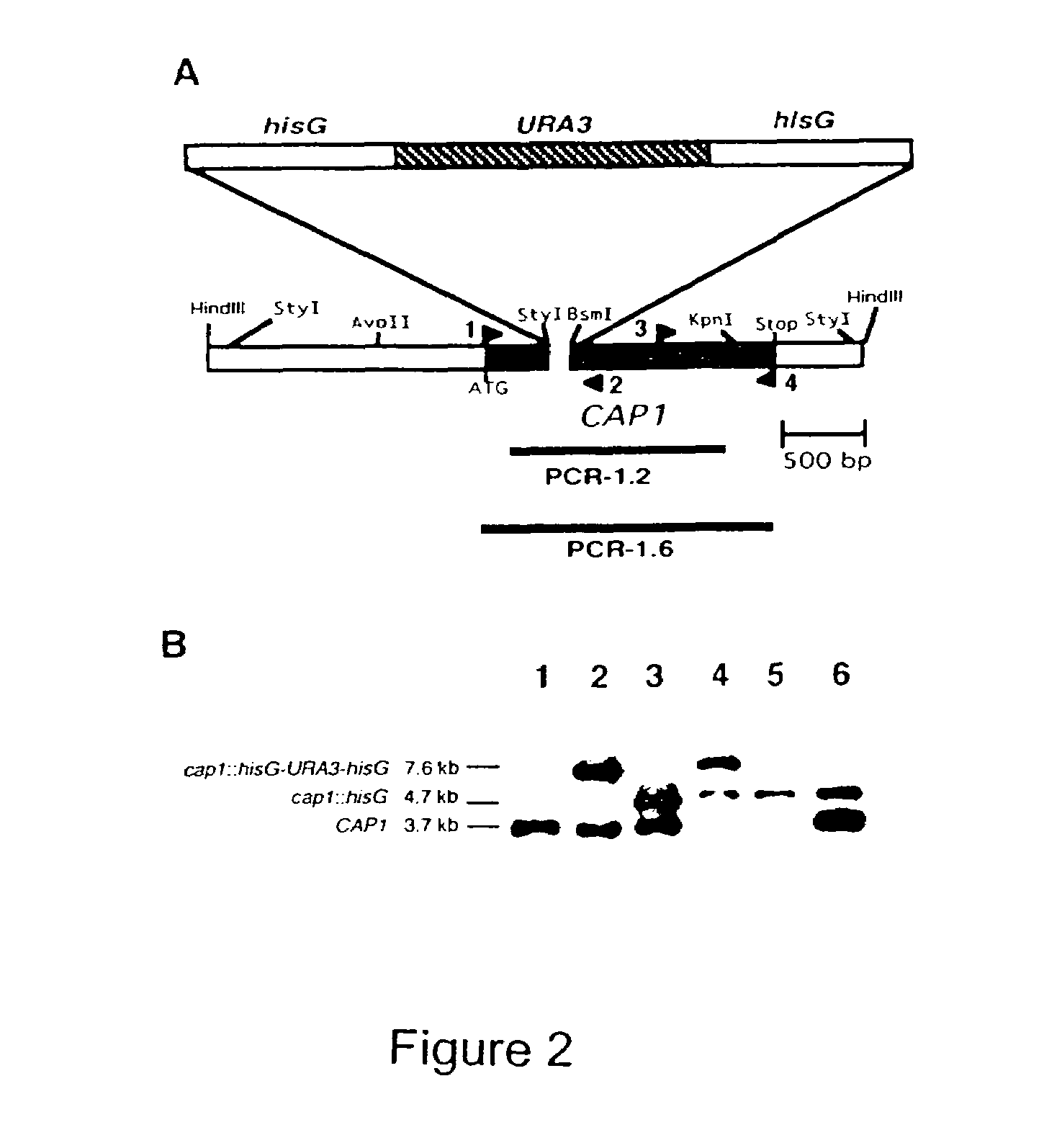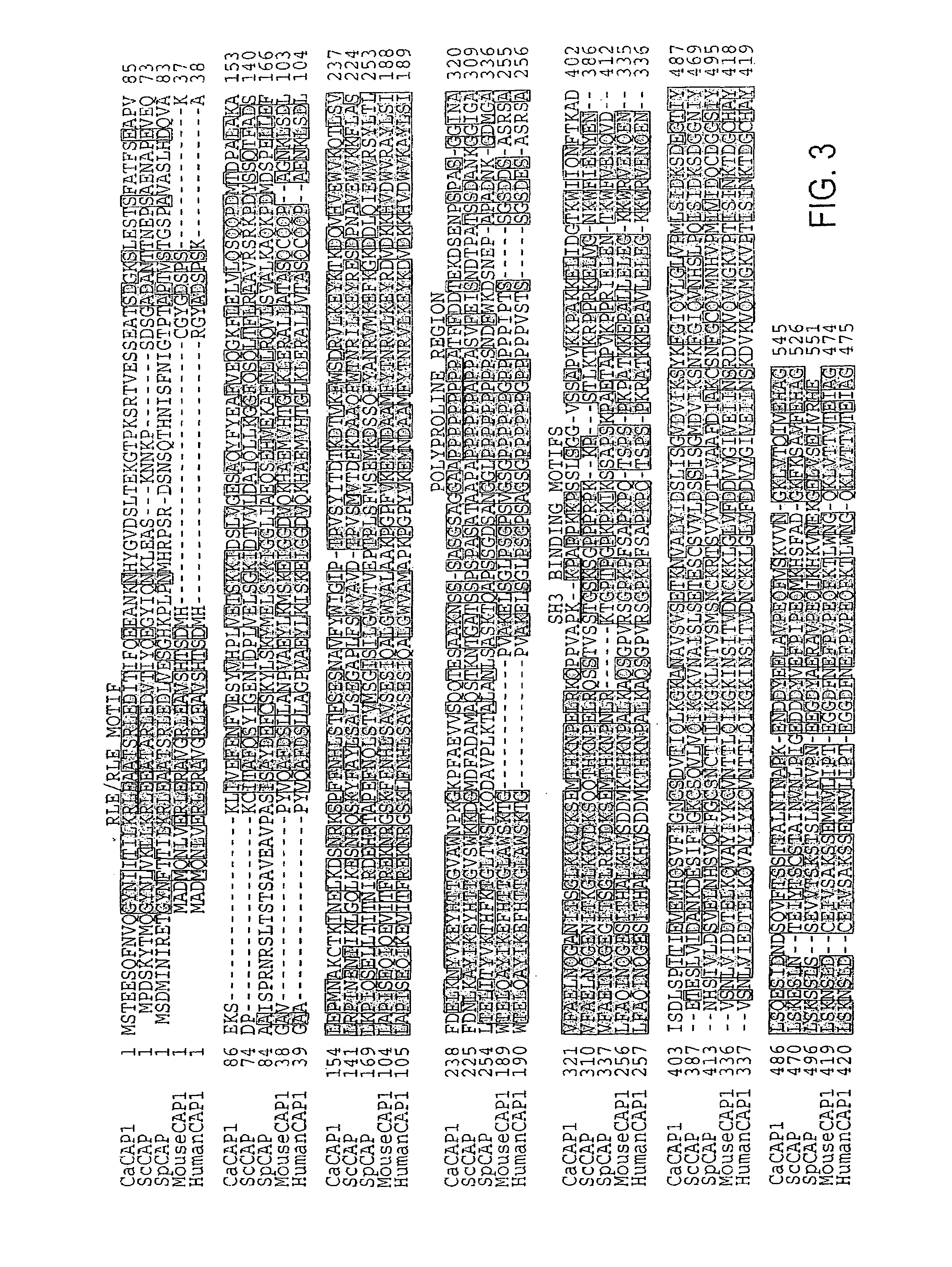Methods for regulating bud-hypha transitions and cAMP levels in Candida albicans
a technology of budhypha and camp level, applied in the field of budhypha transition and camp level regulation in i > candida albicans /i>, can solve the problems of reduced filamentous growth, germ tube formation defect, and inhibition of budhypha transition, so as to reduce filamentous growth, enhance pde2 gene activity, and reduce the effect of germ tube formation d
- Summary
- Abstract
- Description
- Claims
- Application Information
AI Technical Summary
Benefits of technology
Problems solved by technology
Method used
Image
Examples
example 1
C. albicans Strains and Growth Conditions
[0218]The E. coli strain HB101 was used to propagate plasmids (Boyer et al., 41 J. MOL. BIOL. 459-72 (1969)). C. albicans strains are listed in FIG. 1. Yeast forms were grown in yeast extract peptone dextrose (YPD) or yeast nitrogen base containing 50 mM glucose (YNB) (ROSE ET AL., METHODS IN YEAST GENETICS (Cold Spring Harbor Laboratory Press) (1990)). Mass conversion of stationary phase yeasts (grown at 30° C. for 48 h) to germ tubes was induced at 37° C. in the following pre-warmed media, Lee's media (pH 6.8) (Lee et al., 13 SABOURAUDIA 148-53 (1975)), Medium 199 (Gibco-BRL, Carlsbad, Calif.) with 150 mM HEPES (pH 7.0) (M199), M199 containing 5% bovine calf serum (Sigma, St. Louis, Mo.) (M199+serum), 50 mM potassium phosphate (pH 6.0) plus 10% bovine calf serum (Feng et al., supra), 10 mM imidazole-HCl buffer media (pH 7.0) containing 0.2 mM MnC2 with the following inducing agents: 1) 4 mM N-acetylglucosamine, 2) 10 mM L-proline plus 10 mM...
example 2
Isolation and DNA Sequencing of cDNA and Genomic Clones for CAP1
[0221]CAP1 cDNA clones were found while attempting to identify germ tube-specific surface antigens by screening a C. albicans germ tube cDNA library (Sundstrom et al., 174 J. BACTERIOL. 6789-99 (1992)) but cDNAs encoding cell wall surface proteins were not found. Five of the thirteen cDNA clones isolated encoded proteins with homology to adenylate cyclase associated proteins. pBluescript SK-phagemids of the five clones were rescued by in vivo excision (Strategene) according the manufacturer's directions. pCAP1, with a 1655 bp CAP1 cDNA insert was analyzed further.
[0222]Three λ genomic CAP1 clones (CAP2, CAP3, and CAP5) were isolated by screening a λ GEM12 genomic library of C. albicans SC5314 (Birse et al., 61 INFECT. IMMUN. 3648-55 (1993)) with CAP1 cDNA excised from pCAP1 with XbaI and XhoI. pGHCP17 was constructed by subcloning the 3.7 kbp CAP1 genomic HindIII fragment of CAP5 into pBluescript SK- and transforming E....
example 3
Disruption of CAP1
[0224]To disrupt CAP1 in C. albicans, plasmid pCAPURA3 was constructed by replacing 132 bp StyI-BsmI fragment of CAP1 cDNA in pCAP1 with the 4.0 kbp BamHI-BglII hisG-URA3-hisG cassette from p5921 (Fonzi et al., 134 GENETICS 717-28 (1993)) after generating blunt ends using T4 DNA polymerase (Gibco-BRL) and the Klenow fragment of E. coli DNA polymerase I. E. coli HB101 served as the host strain for transformation and propagation of pCAPURA3.
[0225]CAI4 (CAP1 / CAP1, ura3 / ura3) was transformed using spheroplast transformation (Kurtz et al., 6 MOL. CELL. BIOL. 142-9 (1986)) with 10 μg of pCAPURA3 digested with PstI to release the CAP1 disruption cassette. Ura+ transformants with an CAP1 / cap1::hisG-URA3-hisG genotype were identified by Southern blotting using HindIII-digested genomic DNA (Scherer et al., 25 J. CLIN. MICROBIOL. 675-9 (1987)). Southern blots were probed with hisG-URA3hisG from p5921 and PCR-1.2 (FIG. 2A). PCR-1.2 (nucleotides 98 to 1318) was generated by PCR...
PUM
| Property | Measurement | Unit |
|---|---|---|
| length | aaaaa | aaaaa |
| lengths | aaaaa | aaaaa |
| lengths | aaaaa | aaaaa |
Abstract
Description
Claims
Application Information
 Login to View More
Login to View More - R&D
- Intellectual Property
- Life Sciences
- Materials
- Tech Scout
- Unparalleled Data Quality
- Higher Quality Content
- 60% Fewer Hallucinations
Browse by: Latest US Patents, China's latest patents, Technical Efficacy Thesaurus, Application Domain, Technology Topic, Popular Technical Reports.
© 2025 PatSnap. All rights reserved.Legal|Privacy policy|Modern Slavery Act Transparency Statement|Sitemap|About US| Contact US: help@patsnap.com



